Exploring the Cervus Genus: A Scientific Overview
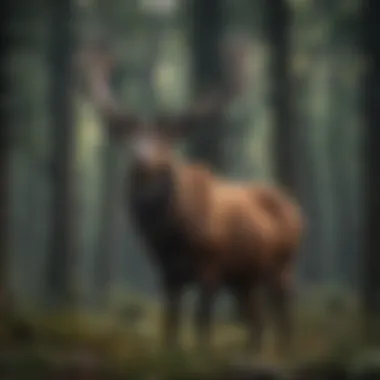
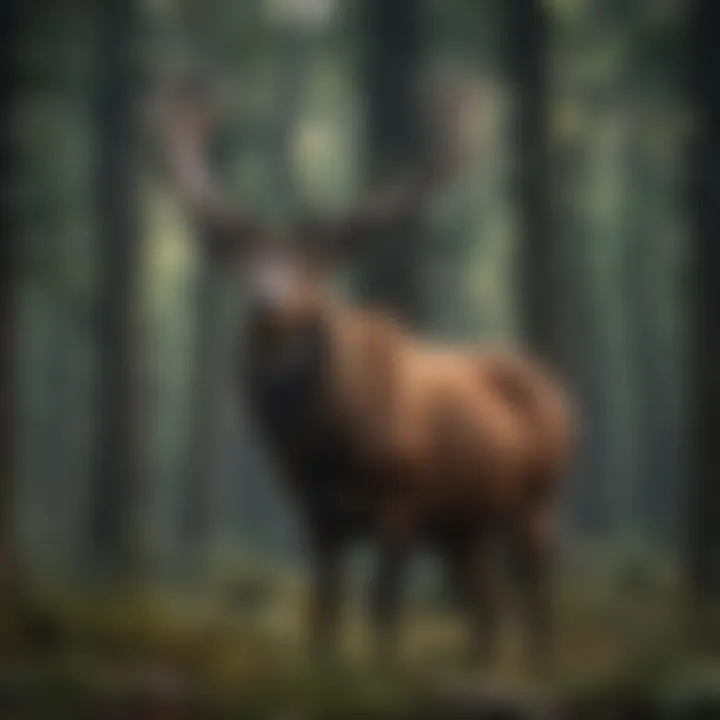
Intro
The Cervus genus, commonly referred to as deer, represents a remarkable category of mammals known for their diverse species and ecological roles. Understanding the Cervus genus is critical for conservation efforts, as their populations face numerous threats due to habitat loss and climate change. This examination focuses on the varied species within the genus, their unique biological characteristics, and the pressing conservation challenges they encounter. In doing so, it aims to provide a thorough overview for students, researchers, educators, and professionals interested in wildlife biology and conservation.
Methodology
Overview of research methods used
Research concerning the Cervus genus typically employs a multifaceted approach. Field studies, laboratory analyses, and ecological modeling are some of the primary methods used to gather data. Field studies often involve direct observation of deer in their natural habitats, allowing researchers to note behavior patterns and interactions within ecosystems.
Data collection techniques
Data collection for studies on Cervus is multifarious and may include:
- Camera traps: These devices help capture images of deer, providing insights into their movement, behavior, and population dynamics.
- Telemetry tracking: Using GPS collars can help in understanding the spatial movement and habitat use of various species.
- Genetic sampling: Collecting tissue samples allows researchers to analyze genetic diversity and examine population structure.
- Surveys and questionnaires: Conducting interviews with local populations provides valuable information on deer-human interactions and conservation perception.
Species Diversity
The Cervus genus encompasses several notable species, including the Red Deer, Elk, and Sika Deer, each exhibiting distinct characteristics.
Red Deer
Red Deer (Cervus elaphus) are among the largest species within this genus, found across Europe and parts of Asia. Their hbehabits and social structure significantly influence their surroundings, contributing to the ecological balance.
Elk
Elk (Cervus canadensis), known for their impressive antlers and vocalizations, populate North America and parts of Asia. They play a crucial role in forest ecosystems by grazing and affecting plant community dynamics.
Sika Deer
Sika Deer (Cervus nippon) are native to East Asia and have a unique coat that varies with the seasons. They are more adaptable to various habitats, contributing to their success across multiple regions.
Ecological Significance
Cervus species contribute to biodiversity and ecological balance through their grazing behavior, which influences vegetation structure and growth. They serve as prey for large carnivores, sustaining the food web.
Conservation Efforts
Many Cervus species are endangered or at risk. Conservation strategies focus on habitat preservation, legal protection, and public education. These efforts aim to maintain healthy populations while addressing the challenges they face.
"The future of Cervus species hinges on our commitment to conservation and sustainable practices."
Future Directions
Upcoming trends in research
Emerging research trends include the use of advanced technologies, such as drones for habitat monitoring and genetic studies to track population health. These innovations can provide critical data for conservation planning.
Areas requiring further investigation
More studies are necessary to understand the impacts of climate change on the habitat and behavior of Cervus species. Examining their adaptability and resilience will be crucial moving forward.
This article aims to foster a comprehensive understanding of the Cervus genus, synthesizing information for effective knowledge dissemination among stakeholders. Understanding the complexities of this genus is vital for informed conservation, ensuring the survival of these magnificent creatures.
Prelude to Cervus
Understanding the Cervus genus is critical for several reasons. This group includes some of the most recognizable and ecologically significant deer species in the world. By learning about Cervus, we can appreciate not only their biological complexity but also their roles in ecosystems and the challenges they face.
Key Points of Interest
Cervus species are characterized by a range of physical, behavioral, and ecological features. Grasping these elements provides insight into their adaptability and the ecological niches they occupy. Moreover, studying the Cervus genus allows researchers to explore evolutionary biology and conservation strategies. This is crucial as many Cervus species are under threat due to habitat loss, climate change, and human activities.
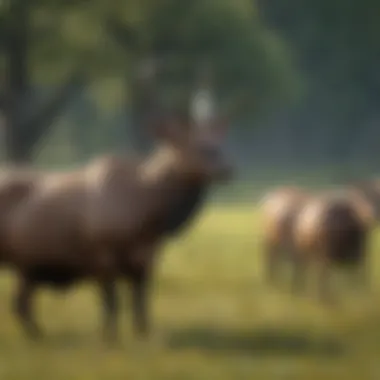
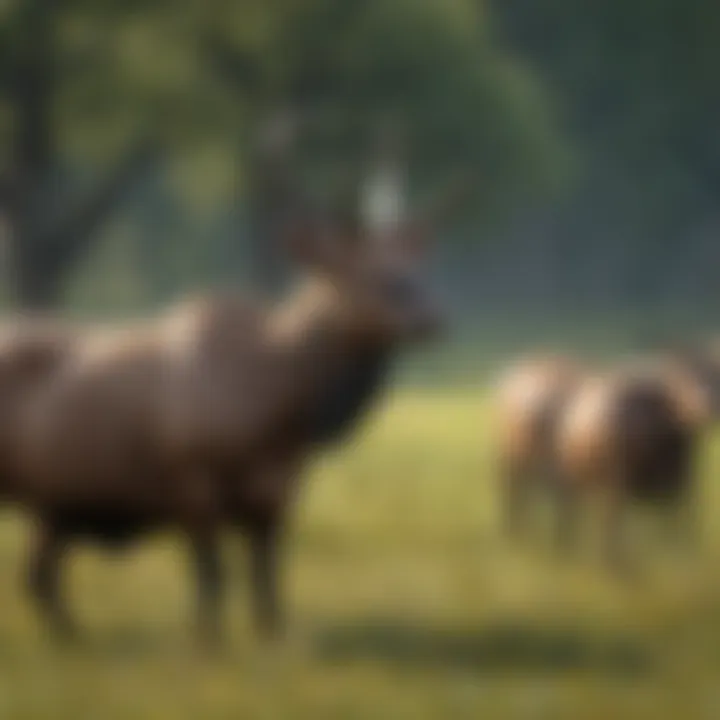
Benefits of Understanding Cervus
- Ecological Impact: Cervus species contribute to their habitats by influencing plant communities and serving as prey for various predators.
- Conservation Needs: Identifying threats to their survival helps prioritize conservation efforts and promote biodiversity.
- Research Opportunities: Various aspects of the Cervus genus can aid scientific research regarding species adaptation and community dynamics.
Cervus is not just an academic subject; it represents broader questions in conservation biology, ecology, and environmental stewardship that affect both wildlife and human populations. Therefore, delving into this genus offers a well-rounded perspective essential for students, researchers, and conservationists.
Physical Characteristics of Cervus Species
The physical characteristics of the Cervus genus are fundamental to understanding its species. These traits not only facilitate the identification of different species but also highlight important adaptations for survival in diverse environments. By examining these characteristics, one can appreciate how each species has evolved to meet ecological demands. Furthermore, physical attributes often play a significant role in social structure, mating habits, and ecological interaction.
Body Size and Antler Development
Body size among Cervus species varies significantly across the genus. Generally, larger species are better adapted to colder climates. For instance, Cervus canadensis, commonly known as the elk, can stand up to 1.5 meters at the shoulder and weigh between 320 to 480 kilograms. This considerable size aids in thermoregulation and grazing efficiency in temperate environments. In contrast, Cervus nippon or the sika deer is much smaller, standing approximately 90 to 100 centimeters at the shoulder, which allows it to navigate through dense underbrush with ease.
Antler development presents another critical aspect of physical characteristics. Antlers are unique to the male members of the Cervus genus. They serve multiple roles, including display for mating and combat with rival males. The growth of antlers typically occurs annually, starting in the spring and shedding in the winter. For example, the antlers of the red deer can reach up to 1 meter in length, displaying impressive branching structures. This size and complexity are significant for attracting females, particularly during the rutting season. The genetic and environmental factors influencing antler growth are topics of continued research, providing insights into fitness and health among different populations.
Fur Patterns and Coloration
Fur patterns and coloration among Cervus species vary, serving key functions such as camouflage and communication. The coloration can range from browns and tans to greys and even reddish tones, depending on habitat and specific species. For instance, Cervus elaphus, or the red deer, features a rich reddish-brown coat in summer, shifting to a darker hue in winter, allowing it to blend with the forest during different seasons.
Fur texture also plays a role in species adaptation. In colder climates, such as those inhabited by the elk, the fur is denser and longer, providing insulation against harsh conditions. The patterns can also serve as social signals. The distinctive spots on the coat of the sika deer help young fawns remain hidden from predators, as they mimic the dappled light on the forest floor.
Moreover, fur can exhibit seasonal changes, affecting coloration and patterns based on reproductive cycles or environmental shifts. This adaptability shows how Cervus species have evolved in response to their surroundings, enabling them to navigate challenges such as predation and climate variations more effectively.
Species Diversity within the Cervus Genus
Understanding the species diversity within the Cervus genus is crucial for comprehending the ecological and evolutionary dynamics of these animals. The diversity represents an array of adaptations that allow these species to thrive in various environments. This section highlights the unique characteristics of each member of the Cervus genus, emphasizing their ecological roles, interactions with other species, and responses to environmental pressures. Additionally, evaluating species diversity provides insight into the evolutionary pathways that have shaped these animals and informs conservation strategies aimed at preserving their habitats and populations.
Cervus elaphus: The Red Deer
Cervus elaphus, commonly known as the red deer, is one of the largest species in the Cervus genus. It displays significant physical characteristics that set it apart. Males, or stags, possess antlers that can reach impressive lengths and are shed annually.s The red deer primarily inhabit forests and woodlands, but they are also found in open country. They are capable of adapting to various habitats, including montane regions. Their diet consists mainly of grasses, leaves, and young shoots, which efficiently supports their large body size.
The social structure of red deer consists of herding behavior, particularly during the rutting season. During this period, stags engage in vocalizations and displays to establish dominance and attract mates. This ritual is significant for genetic diversity as it influences which males reproduce with which females.
Cervus canadensis: The Elk
Cervus canadensis, known as the elk or wapiti, is noted for its size and distinctive vocalizations, particularly the bugle made by males during the breeding season. Elk can vary in size based on their geographical location, with the Rocky Mountain elk being among the largest subspecies. Their habitats range from mountainous regions to grasslands. The elk primarily graze on a diet of grasses and shrubs, demonstrating their adaptability to seasonal changes in food availability. Elk social structures typically involve matrilineal herds led by a dominant female. Males often separate from the herd during the mating season. Their vocalizations play a key role in communication, especially in establishing territory and attracting females. Conservation efforts have focused on managing hunting and preserving natural habitats to ensure healthy elk populations, which are vital indicators of ecosystem health.
Cervus nippon: The Sika Deer
Cervus nippon, or the sika deer, is distinguished by its relatively small size and varied coat color, which can range from spotted to solid dark tones. The sika deer is native to East Asia and has established introduced populations elsewhere, including some parts of North America and Europe. Versatile in their habitat preferences, they thrive in mixed forests and grasslands, configuring their behavior based on available resources. Sika deer generally exhibit both solitary and social behavior. Males have a unique method of communication, which includes diverse vocalizations, particularly during the mating season. Their diet consists mainly of grasses and leaves, adapting as necessary to local vegetation. The introduction of sika deer to new regions raises management concerns about their impact on local ecosystems, particularly where they compete with indigenous species. Monitoring these populations is crucial to maintaining ecological balance.
Understanding these species not only informs us about the evolutionary history of the Cervus genus but also highlights the pressing need for tailored conservation efforts.
Habitat and Distribution
Understanding the habitat and distribution of the Cervus genus is essential for elucidating their ecological roles and conservation needs. Cervus species are typically found in diverse environments, revealing their adaptability. These deer thrive in regions that range from dense forests to open grasslands. Their habitat choices have significant implications for their survival, reproductive success, and interactions within ecosystems.
Preferred Habitats
Cervus species prefer habitats that provide adequate food, cover, and water sources. Commonly, they are associated with:
- Forests: These areas provide ample shelter and foraging opportunities, and the underbrush supports diverse plant life. Species such as Cervus elaphus are often seen in temperate forests.
- Grasslands: Open fields offer a different set of resources. Cervus canadensis, or elk, for instance, frequent these areas for grazing during specific seasons.
- Wetlands: These habitats are crucial for various life stages, particularly during migration or when raising young. Availability of water sources ensures healthy ecosystems.
Additionally, while some Cervus species have preferences, flexibility to adapt to changing environments is notable. This leads to occasional seasonal migration in search of food or shelter.
Geographical Range of Cervus Species
The geographical spread of Cervus is vast. Species inhabit various regions, each adapted to specific climates and conditions. Some key points include:
- Cervus elaphus (Red Deer): Found across Europe and parts of Asia, they occupy a range of habitats, from mountainous terrains to woodlands.
- Cervus canadensis (Elk): Predominantly in North America but also in parts of Asia. Their range covers forests, grasslands, and mountains, adapting well to changing altitudes.
- Cervus nippon (Sika Deer): This species has a more restricted range, found primarily in East Asia. They thrive in temperate forests and grasslands, showcasing adaptability far within varied ecosystems.
Understanding the habitat requirements and range of Cervus species is vital for implementing effective conservation strategies. Habitat loss and fragmentation threaten their survival, making it crucial to prioritize preservation efforts.
"The importance of habitat preservation cannot be overstated. It is fundamental not just for Cervus species, but for entire ecosystems that depend on their presence."
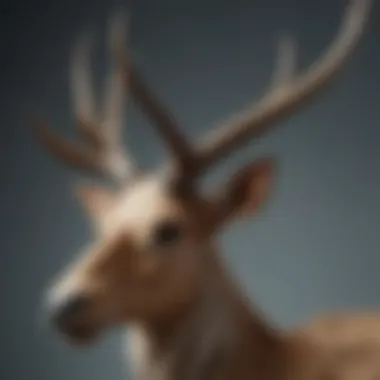
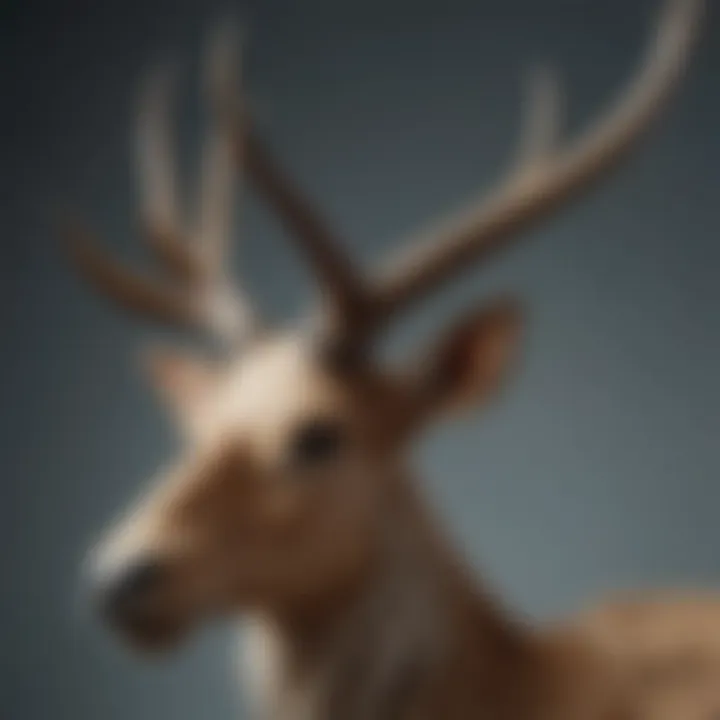
To learn more about the habitat preferences of Cervus, you can explore resources such as Wikipedia or Britannica.
Behavioral Traits of Cervus
Understanding the behavioral traits of Cervus is critical to grasp the complexities within the genus. Behavioral patterns not only define species interactions but also impact their survival strategy in varying environments. The social structure, diet preferences, and mating behaviors are interconnected aspects that elucidate how these animals adapt and thrive.
Social Structure and Group Dynamics
Social structure in Cervus species is highly variable, influenced by environmental factors, predator presence, and resource availability. Generally, many species tend to form herds, which offer both protection and collaborative opportunities for foraging. The size of these herds can vary. For instance, in periods of abundant resources, Cervus elaphus or red deer can form large groups, whereas during harsher seasons, they may break into smaller, more manageable packs.
The hierarchy within these groups often reflects individual age, size, and fitness. Dominant males typically lead the herd, especially during mating seasons. This separation of roles is crucial. The leaders signal when to flee from threats and when to migrate to new feeding grounds. By taking time to observe these patterns, researchers gain insight into the species' adaptability and social behavior.
Feeding Habits and Diet
Feeding habits among Cervus species vary depending on their habitat. Most are herbivorous, primarily grazing on grasses, shrubs, and tree foliage. In various environments, their diet may include fungi and herbs, which offers necessary vitamins and minerals. Grazing behavior is highly seasonal and often dictated by the availability of food.
For example, Cervus canadensis, known as the elk, displays seasonal feeding strategies. During summer, they graze on lush green vegetation, which is abundant in their native areas. However, during winter months, they adapt by scavenging on bark and twigs. Such adaptability in feeding habits reflects the evolutionary traits of the Cervus genus. Furthermore, understanding their feeding behavior sheds light on their ecological roles within their respective habitats.
Mating Rituals and Reproductive Behavior
Mating rituals are an essential aspect of Cervus behavior. These rituals primarily occur during the autumn months when males engage in elaborate displays to attract females. The displays often include vocalizations, known as roaring or bugling, along with antler displays, where males clash antlers to establish dominance.
The reproductive process is typically competitive, with dominant males securing mating rights with multiple females. Mating behaviors can vary widely across species. For example, Cervus nippon, or sika deer, might engage in more subtle courtship behavior, relying on scent marking and visual cues rather than the loud displays of the red deer. This diversity in reproductive strategies demonstrates the adaptability of Cervus to their environments.
Understanding these behavioral traits informs conservation strategies. Knowledge of social structure, feeding habits, and mating behaviors can enhance efforts in habitat management and species protection.
In summary, the behavioral traits of Cervus encompass a range of aspects that are vital for their functional roles in ecosystems. These traits highlight not only how they survive but also how they interact with their environment, forming a complex web of ecological interdependencies.
Ecological Significance of Cervus
The ecological significance of the Cervus genus is a crucial aspect of understanding its role in various ecosystems. Cervids, including deer and elk, contribute to biodiversity and play critical roles in food chains. Their foraging habits help shape plant communities and influence the availability of food resources for other species. This has implications for both flora and fauna within their habitats, making them key players in maintaining ecological balance.
Role in Ecosystems
Cervus species serve as herbivores within their ecosystems, primarily consuming a wide range of vegetation. By grazing on grasses, shrubs, and young trees, they help regulate plant growth. This not only maintains the health of plant communities but also supports various wildlife that depend on these habitats for survival. Further, their movements through the environment promote seed dispersal, aiding in plant reproduction and genetic diversity.
In addition to their role as consumers of plant matter, these animals also become prey for larger carnivores like wolves and bears. This creates a dynamic balance, as predator populations depend on the abundance of Cervus species for sustenance. Thus, the presence of deer and elk can indirectly affect populations at different trophic levels, showcasing their integral role in food webs.
Impact on Plant Communities
The interaction between Cervus and plant communities is multifaceted. By browsing on various plants, they can prevent the overgrowth of any single species, fostering a diverse ecosystem. In areas heavily populated by Cervus, one might observe a reduction in certain plant species, which helps maintain a mosaic of habitats suitable for various organisms.
However, dense populations of Cervus can lead to overgrazing, adversely affecting the landscape. Overgrazing can result in soil degradation and a decline in plant diversity, leading to erosion and ecological collapse in severe cases. This highlights the importance of balanced populations and the need for effective management strategies.
In essence, the Cervus genus stands as a pillar within its ecosystems, influencing plant dynamics and contributing to overall ecological health.
The importance of the Cervus genus transcends mere physical presence. Their role as herbivores, combined with their interactions with other species, creates ripple effects that highlight their ecological significance. The health of ecosystems is intimately connected to the dynamics of Cervus populations, necessitating careful monitoring and conservation efforts.
Conservation Challenges Facing Cervus
The conservation of the Cervus genus is critical for ecological balance and biodiversity. Understanding and addressing the challenges these species face is essential not only for their survival but also for the overall health of their habitats. The pressures exerted by human activities have reached alarming levels, necessitating immediate action and thoughtful solutions.
Habitat Loss and Fragmentation
Habitat loss is perhaps the most significant threat to Cervus populations. Urbanization, agriculture, and infrastructure development have significantly reduced the areas where these deer can live and thrive. The natural landscapes that support Cervus species are increasingly being transformed into urban habitats or farmland. This transformation disrupts migration patterns and reduces genetic diversity, which is crucial for adapting to changing environments.
Fragmentation of habitats restricts animal movement. When land is divided into smaller patches, it limits the ability of Cervus to find food, mates, and other vital resources. This isolation can lead to inbreeding, which can weaken populations over time. Natural corridors and protected areas can help mitigate some of this fragmentation, but they require planning and investment.
The consequences of habitat loss and fragmentation are manifold:
- Reduced habitat availability: Smaller areas can only support fewer individuals.
- Increased competition: Limited resources lead to heightened competition among species.
- Higher vulnerability to external threats: Isolated populations are less resilient to diseases and climatic changes.
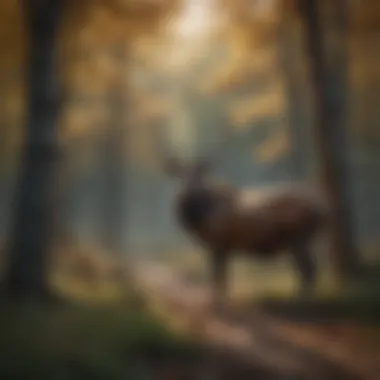

Overhunting and Illegal Poaching
Another pressing concern for Cervus is overhunting, often exacerbated by illegal poaching. While regulated hunting can help manage populations, unchecked hunting pressures can devastate local herds. The high value of antlers and meat on the black market creates an incentive for poachers to target certain species, leading to dramatic population declines.
Overhunting typically results in:
- Population imbalance: Removing too many males or females disrupts breeding.
- Loss of genetic diversity: Smaller populations are more susceptible to extinction.
Efforts to curb illegal poaching have begun to take shape, with conservation organizations collaborating with local governments to enhance enforcement and raise public awareness. These efforts can be complemented by community engagement initiatives that encourage locals to protect wildlife instead of viewing them as resources.
"Effective conservation strategies not only aim to protect species from extinction but also involve the communities that live in proximity to these animals, promoting coexistence and stewardship."
The complexities of these conservation challenges require a multifaceted approach. Scientific research, community involvement, and effective policy implementation are crucial to ensure the longevity of Cervus species in the wild.
Cervus Conservation Efforts
Conservation efforts for the Cervus genus are vital for ensuring the survival of these species amid various threats. As awareness grows around biodiversity loss, recognizing the unique role Cervus plays in ecosystems remains critical. These efforts often involve protecting habitats, preserving genetic diversity, and fostering cooperation among different stakeholders. Effective conservation strategies not only help the Cervus population but also contribute to the overall health of their ecosystems and the planet.
Protected Areas and Wildlife Reserves
Protected areas and wildlife reserves play a key role in conserving Cervus species. These regions provide safe havens from human encroachment, habitat destruction, and poaching.
- Designation of Areas: Governments and organizations prioritize establishing protected zones where Cervus species can thrive. Examples include established parks like the Yellowstone National Park in the United States and the Banff National Park in Canada, which hosts significant populations of Cervus canadensis.
- Management Strategies: Effective management strategies are necessary to maintain these areas. Monitoring populations, enforcing anti-poaching laws, and conducting habitat restoration projects help ensure the long-term survival of Cervus. Collaboration with local communities enhances these efforts, making them more sustainable.
- Biodiversity Conservation: Protected areas not only benefit Cervus but also other native wildlife. Biodiversity as a whole can enhance ecosystem resilience, utilizing resources effectively.
"A well-managed protected area can counteract the negative impacts of habitat loss by providing crucial breeding grounds for endangered species."
Community Engagement and Education
Community involvement is fundamental to the success of conservation efforts for Cervus. When local communities actively participate, conservation strategies are more likely to succeed.
- Education Programs: Raising awareness about the ecological importance of Cervus and the threats they face is essential. Educational initiatives can inform the public about sustainable practices, fostering a culture of stewardship over wildlife.
- Local Participation: Engaging locals in conservation efforts creates shared responsibility. Communities often have valuable traditional knowledge regarding their natural surroundings. Utilizing this knowledge can enhance conservation techniques.
- Economic Incentives: Supporting local economies through eco-tourism can also promote conservation. When people see value in protecting Cervus habitat, they are more likely to support conservation initiatives.
In summary, Cervus conservation efforts demonstrate the interplay between protected areas, community engagement, and education. Recognizing the significance of these elements contributes to the sustainability and effectiveness of conservation. Addressing the challenges faced by the Cervus genus requires collective action across multiple fronts, ensuring that these species can continue to exist for generations to come.
Future Research Directions
The exploration of the Cervus genus presents a multitude of avenues for future research. Understanding the changing dynamics and challenges facing these species is vital for developing effective conservation strategies. As the environment evolves, so too must our methods of studying and preserving these magnificent animals. Two prominent areas for investigation are genetic studies and climate change impacts, each carrying significant implications for the ecological balance and biodiversity.
Genetic Studies and Population Dynamics
Genetics plays a crucial role in unraveling the complexities of population dynamics within the Cervus genus. Research in this area can shed light on genetic diversity, which is vital for resilience against diseases, environmental changes, and other stressors. It is important to examine how natural selection and genetic drift influence the survival of various Cervus species.
Increased understanding of genetics will allow for better management of populations in different habitats. For instance, through genetic analysis, researchers could identify distinct populations that may require separate conservation efforts.
Another benefit of genetic studies involves tracking gene flow between populations. This tracking can highlight how human activities, such as urban development and deforestation, isolate populations, leading to reduced genetic interchange.
"Considering genetic variability is essential for the long-term sustainability of Cervus species."
Climate Change Impacts on Cervus
Climate change is an overarching threat that potentially alters habitats and resources critical to the survival of Cervus species. Investigating how rising temperatures and shifting weather patterns affect behavior, diet, and reproduction offers insight into the future of these animals.
Research can focus on the phenological responses of Cervus species to climate change. This refers to the timing of seasonal activities and how these may change in response to environmental stressors. For example, if food availability changes due to weather patterns, it could impact mating rituals or the timing of fawning.
Studying the effects of climate on habitats can also reveal important information. As certain areas become less hospitable, Cervus may need to migrate in search of suitable conditions. Mapping these potential migration patterns will be crucial for conservation planning.
In summary, future research directions are vital in enhancing our understanding of the Cervus genus. Genetic studies and the implications of climate change need robust attention. Such investigations not only inform conservation practices but also contribute to the broader discussions of biodiversity and ecological health.
Culmination
The conclusion serves as a crucial aspect of discussions surrounding the Cervus genus. It synthesizes key findings and emphasizes the overall significance of these species. Understanding Cervus is vital for multiple reasons.
Summarizing the Significance of Cervus
Cervus species play a significant role within terrestrial ecosystems. They contribute to biodiversity and serve as a vital element in food chains. Their impact goes beyond ecological balance. Studies show that these deer influence vegetation patterns and seed dispersal, thus affecting plant community structures.
Conservation efforts are pivotal in safeguarding not only unique species but also the ecosystems they inhabit. The decline of Cervus populations is indicative of broader environmental issues, including habitat loss and climate change.
Moreover, enhancing awareness regarding these animals can lead to better research and policy initiatives. Educating communities on the importance of these species fosters a collective responsibility toward conservation. The health of Cervus populations can reflect the health of entire ecosystems.







